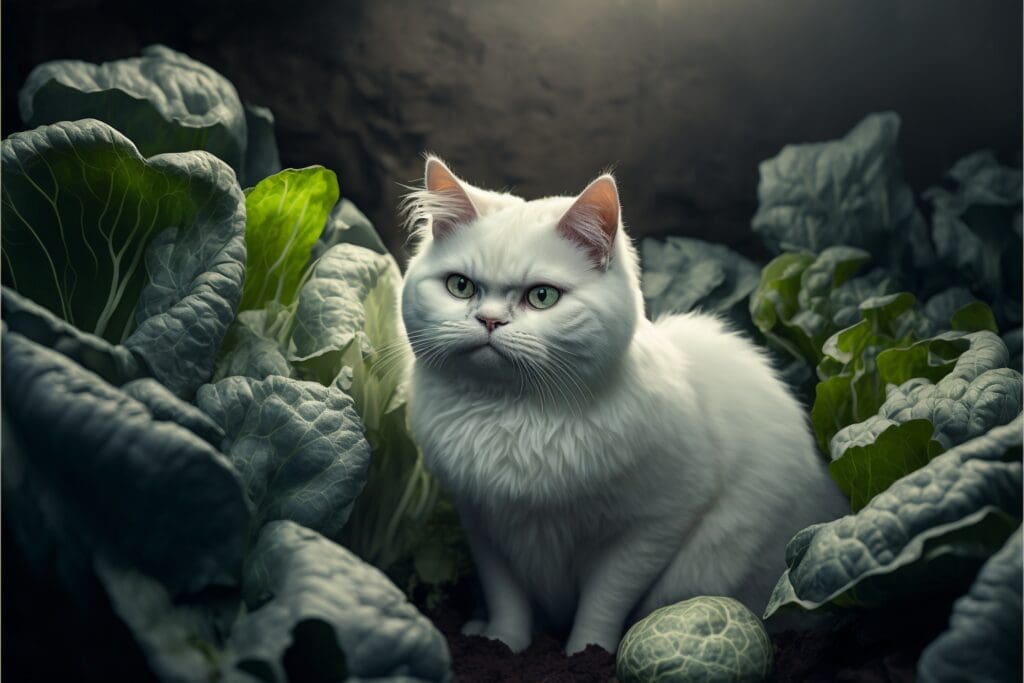Last Updated on January 31, 2023 by admin
Cats can eat lettuce without any serious adverse effects. As long as the lettuce is properly rinsed of pesticides and dirt there is no reason a cat cannot be given lettuce. If the lettuce has any dirt or worms these can give your cat parasites. While the lettuce is safe for your cat to consume and might have some minor benefits like providing fiber and additional hydration, there are no clear health benefits that make it superior to proper cat food. So while safe for your cat it is not something most would recommend.
Introduction: Can Cats Eat Iceberg Lettuce?
Many cat owners are often curious about what their beloved pets can and cannot eat. Iceberg lettuce is one of the most common types of lettuce, and many owners may be wondering if their cats can safely eat it. The good news is that cats can eat iceberg lettuce, as long as it is fed to them in moderation. While it has little nutritional value, it can still be a fun and flavorful snack for cats in small amounts.
A Closer Look at Iceberg Lettuce and Its Nutritional Value
Iceberg lettuce is one of the most common types of lettuce and it is generally safe for cats to eat in small amounts. It is low in calories, but also low in nutrients, so it doesn’t provide much in the way of health benefits. Iceberg lettuce does contain some vitamins and minerals, such as vitamin A, vitamin K, calcium, and magnesium. It also contains some dietary fiber. Despite its nutritional value, iceberg lettuce should not be a staple of your cat’s diet.
The Pros and Cons of Feeding Iceberg Lettuce to Cats
As with most foods, there are both pros and cons to feeding your cat iceberg lettuce. On the plus side, iceberg lettuce is low in calories and contains trace amounts of vitamins and minerals, making it a great, low-calorie snack for cats who are trying to maintain a healthy weight. Additionally, the crunchy texture of iceberg lettuce can help provide dental stimulation and even help clean your cat’s teeth.
On the other hand, iceberg lettuce is not a particularly nutritious food for cats. While it does contain trace amounts of essential nutrients, it is not a complete food and cannot provide all the nutrients that cats need to stay healthy. Additionally, since cats are not adapted to digest plant-based diets, the fiber in iceberg lettuce can cause digestive problems like diarrhea or vomiting if eaten in large quantities. Therefore, if you do choose to feed your cat iceberg lettuce, it should only be done in moderation.
What Other Vegetables Can Cats Eat?
Although iceberg lettuce is not ideal for cats, there are plenty of other vegetables that your cat can enjoy. If your cat does not like iceberg lettuce, you can try offering them other types of lettuce such as romaine, Chinese leaf, or butterhead lettuce. These types of lettuce contain more nutrients and fiber than iceberg lettuce and may be more palatable for cats. In addition to lettuces, other vegetables that are safe for cats to eat include carrots, sweet potatoes, peas, green beans, broccoli, and cauliflower. These vegetables provide essential vitamins and minerals that can help support your cat’s overall health and wellbeing. When introducing new vegetables to your cat’s diet, it is important to start with small amounts and gradually increase the portion size to avoid any digestive upset. The most popular vegetables used in cat food and treats are potatoes, peas, and red lentils. However, meat is the most crucial and dominant ingredient in any healthy cat diet since cats are obligate carnivores.
The Benefits of Including Vegetables in Your Cat’s Diet
Including vegetables in your cat’s diet can be beneficial for their overall health. Lettuce and other leafy greens provide essential vitamins, minerals, and fiber that cats need for a balanced diet. Leafy greens can also help with digestion and provide your cat with essential nutrients that are difficult to find in their regular diet. Additionally, some cats may find the crunchiness of lettuce and other greens to be a fun experience. Adding vegetables to your cat’s diet can also help keep them hydrated, as most vegetables contain a lot of water. With the right balance of vegetables, your cat may even enjoy them as a tasty treat! However, unless you have a specific health goal in mind or were advised by your veterinarian you should generally avoid adding vegetables of your own to a cat’s diet.
Why Some Cat Owners Should Avoid Feeding Iceberg Lettuce to Their Pets
Although iceberg lettuce is generally safe for cats to eat, there are some reasons why some cat owners should avoid feeding it to their pets. The most important of these is that iceberg lettuce has little nutritional value and can cause digestive issues in cats if consumed in large amounts. It can also lead to dehydration due to its high water content, so it’s not a good choice for cats who don’t drink enough water. Additionally, its low fiber content can lead to constipation, so it’s not a good choice for cats with digestive issues. Finally, the high nitrate content in iceberg lettuce can cause anemia in cats, so it’s best to avoid feeding it to cats with anemia or other blood disorders.
Healthy Alternatives to Iceberg Lettuce for Your Cat’s Diet
It’s important to remember that most cats don’t need to have vegetables or other plant-based foods in their diet in order to stay healthy. If you do decide to provide your cat with vegetables, it’s important to make sure that they are properly cooked and not fed raw. Cats can benefit from having some variety in their diet as long as it’s safe for them to eat. Be sure to consult with your veterinarian about the best diet for your cat.
